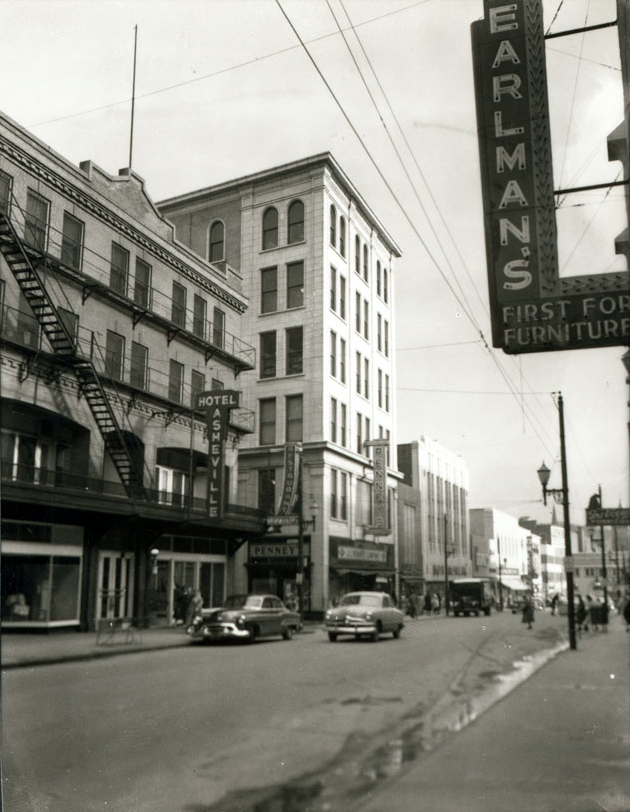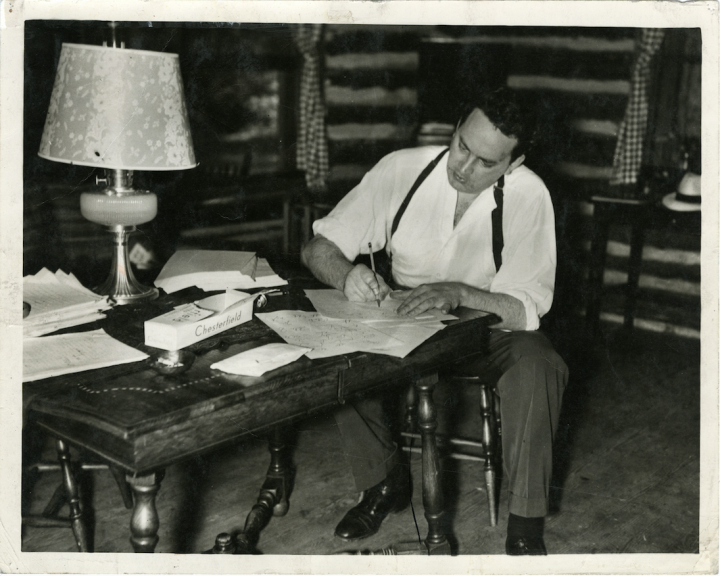There’s no shortage of threats to Asheville’s historic homes, commercial buildings, landscapes and neighborhoods, notes Jack Thomson, executive director of The Preservation Society of Asheville and Buncombe County. And while he sees the area’s current real estate boom as the single biggest issue, another key problem is public misconceptions about the different preservation programs — and the widely varying degrees of protection they confer.
“In my experience, a really large segment of the general public knows just enough to be dangerous,” says Thomson. And many owners of historic properties, he continues, don’t understand the benefits these programs provide — or the restrictions that come with them. For these reasons, he believes, outreach and education efforts are essential.
In addition to the Preservation Society’s work, the Historic Resources Commission of Asheville and Buncombe County has designated four local historic districts, all within city limits: Albemarle Park, Biltmore Village, Montford and St. Dunstan’s. At the federal level, the National Register, an arm of the National Park Service, recognizes three of the HRC’s four districts and also lists downtown Asheville as a historic district. St. Dunstan’s, which sits between Biltmore Avenue and McDowell Street just above Biltmore Village, isn’t on the national list.
This is only the tip of the iceberg, however: Other federal and state designations may also come into play. Meanwhile, there are dozens of individual historic sites as well, and many more old buildings that aren’t recognized at all but that still contribute to people’s experience of downtown Asheville.
Little wonder, says Thomson, that preservation programs “all get thrown together by the general public into the Ninja Juicer. It’s no fault of theirs: It’s our fault for not establishing a stronger individual identity between the various entities.”
Nonetheless, these distinctions have significant real-world repercussions. Among the greatest mistakes, he says, is assuming that inclusion in any of these programs confers absolute protection. This is particularly true for the National Register: In theory, for example, such iconic downtown structures as the Battery Park Senior Apartments, the former S&W Cafeteria and the YMI Cultural Center could all get torn down.

Against that backdrop, Thomson and other local folks are working hard to preserve what they can of Asheville’s historic character. Various tax credits and preservation easements offer financial benefits to owners of historic properties; advocates also tout broader benefits, such as job creation, the reduced environmental impacts of restoration versus demolition and the intangible value of connecting the present with the past.
But while lack of time and/or money is often the biggest challenge confronting individual preservation projects, some advocates pose a more existential question: Given the area’s high cost of living and persistent lack of opportunity for long-standing segments of the local population, who exactly are we preserving the city’s history for?
A growing awareness
President Lyndon Johnson signed the National Historic Preservation Act into law on Oct. 15, 1966, establishing the National Register of Historic Places and the National Historic Landmarks program and requiring states to appoint a historic preservation officer. Designated landmarks are included in the National Register.
A decade later, the U.S. celebrated its bicentennial; that same year, our local Preservation Society was formed. For the first 16 years, the nonprofit was run by volunteers, notes founding member Betty Lawrence. Early on, the group led workshops and other educational programs; later it began raising money to buy historic properties that were at risk. More recently, the group launched an easement program. But the secret of the organization’s continued success, says Lawrence, “has been its spunk.”
In 1979, Asheville and Buncombe County established the joint Historic Resources Commission. The HRC’s 2015 Historic Preservation Master Plan chronicles the growth of local interest in preserving the area’s past. In 1981, the plan notes, city voters “turned down a bond referendum that would have provided funds to demolish 11 blocks of the downtown” to make way for a mall. The vote’s decisive margin “was an affirmation of the value of Asheville’s historic commercial core, even before conditions were ripe for millions of dollars of investment in revitalization.”
Throughout the 1980s and ’90s, pioneering local preservation advocates continued to promote and fund key projects. Among the most influential early voices were redevelopers Pat and Roger McGuire; Karen Tessier, executive director of Asheville-Buncombe Discovery; Julian Price and Pat Whalen of Public Interest Projects; and Carol King of the Pack Square Conservancy and the Asheville Downtown Commission.
Much of Asheville’s current appeal, stresses Lawrence, is due to the work of these trailblazers. But the Asheville resident, who’s also served on the Historic Resources Commission, cautions against complacency. “Let us not become victims of our success,” she urges, echoing other local advocates. “We still don’t have a downtown [local historic] district. A lot of change could happen.”
Those vulnerable structures include “the many brick, two- to three-story buildings downtown,” says Jennifer Cathey, a restoration specialist with the state Historic Preservation Office. “They are the glue that holds the historic district together, and it’s their assemblage, in addition to the over-the-top great buildings like the S&W and Jackson Building, that make the downtown distinctive and authentic.”
Buildings with benefits
All told, the National Register lists 59 sites in Asheville, plus another 26 in Buncombe County outside city limits. The county also has two national historic landmarks: Biltmore Estate and the Thomas Wolfe Memorial. In addition, there are 47 local historic landmarks in the city and county, some of which are also on the National Register.
Although inclusion in the federal list doesn’t guarantee protection, local preservation groups typically apply that agency’s guidelines when evaluating the historical importance of a property or place.
Usually, says Thomson, buildings must be at least 50 years old. They must also meet one of four other criteria: be identified with a particular individual from the past (what he calls the “George Washington slept here” model); have architectural significance; be connected with a particular group of people or aspect of American culture; or be associated with a specific American movement. In addition, the property must have retained its physical character or archaeological features.
The first federal tax credit for rehabilitating historic structures was established in 1976. For income-producing properties, that credit now stands at 20 percent of the qualifying rehabilitation expenses. Since the program’s introduction, Buncombe County has had 181 such projects, with a total investment of over $156 million, says Cathey.
A 1998 state program matched the federal tax credit while also offering a 30 percent credit for restoring historic properties that didn’t generate income. Before its cancellation in 2014, this program had generated over $1.36 billion worth of private investment in North Carolina’s historic resources and created more than 23,000 new full-time jobs, Cathey’s office estimates. Buncombe County alone has seen 115 historic homes renovated since 1998, representing nearly $24 million in eligible investments.
A new state program begun in 2016 offers tax credits ranging from 10-15 percent, based on costs and eligibility. And for locally designated landmarks, the city and county offer a 50 percent property tax deferral that continues as long as the requirements are met. Meanwhile, the Preservation Society also offers easements that give property owners substantial tax breaks.
Help vs. hassle
Some property owners, though, choose to forgo those financial incentives. Asheville architect Jane Mathews recalls one recent client’s decision to decline the benefits available for a commercial building project. That still baffles Mathews, who’s worked on local historic properties since 1980.
“It’s free money,” she says. “To me, it makes sense. But I think people feel like maybe the rules or regulations are going to be too strict.”
The federal programs do require owners of National Register properties to follow specific guidelines, but only if they’re seeking tax credits or grants to offset renovation costs.

Public Interest Projects was formed in 1991 to invest in downtown Asheville businesses and real estate, and restoration remains part of the overall mission, says Vice President Karen Ramshaw. Yet she’ll be the first to note that such efforts can generate plenty of headaches.
One of the company’s earliest downtown projects involved converting the upper floors of the former J.C. Penney building into condominiums. The Haywood and Walnut Street sides, Ramshaw explains, are considered “primary historic facades; you can’t have any vents or anything else through those walls.” That forced the restoration project to seek creative solutions. In one unit, she says, it meant placing “the washer and dryer in the master bathroom,” which left potential buyers scratching their heads.
In other cases, the cost of satisfying historic preservation requirements may exceed the dollar value of the tax credits. “Sometimes you have to let the incentive go,” notes Ramshaw. And while she strongly supports efforts to restore historic structures, she also cautions that “It’s going to take longer and cost more than you think.”
Costs and benefits
Asheville attorney Jim Siemens reiterates this point when discussing his recent purchase of the 1868 Patton-Parker House. The Charlotte Street property is unique in its triple status: listed in the National Register, recognized as an HRC local landmark and covered by a Preservation Society easement.
“I went through a year of hearings before I even felt comfortable closing on the property,” says Siemens, who’s converted the historic home to offices for his law firm. The process, he notes, involved a Planning and Zoning Commission hearing, four HRC hearings and one before City Council.
And while Siemens considers the project a success, it remains “the most expensive thing I’ve ever done in my life,” he says. “I spent $30,000 in the due diligence period on architects and landscape architects and the submissions of plans to go through the review process.”

Nonetheless, Siemens encourages anyone with the requisite levels of interest and financial ability to go for it. Collaboration, he maintains, is the key to a successful project. “Seek out advice from people that have done it, and from the Preservation Society and the city, and take a positive, collaborative approach.”
Even property owners who choose to forgo the tax credits, however, may have to contend with some restrictions — and the greater the property’s level of protection, the more extensive the regulation.
The National Register is the broadest (and, therefore, least binding) program. Unless some form of federal or state financial assistance is involved, project review is not required: Property owners are free to do as they like. The hope is that the official recognition will inspire a desire to preserve the resource, but there are no guarantees.
At the local level, both regulation and protection increase. Homeowners in Asheville’s four local historic districts are required to follow the HRC’s design guidelines for all exterior work on the property, including landscaping.
“People think that preservation freezes places in time and doesn’t allow for new development,” notes Stacy Merten, the commission’s director. But in fact, she maintains, preservation “provides a context for new development.”
And though the HRC can reject designs that don’t meet its criteria, the commission can’t ultimately stop a property owner from tearing down a building. “It’s really hard to prohibit demolition in the local or national district. There’s a lot of things in the way that make it more difficult, but it’s not precluded,” Merten explains. In the local districts, demolition can be delayed for up to a year; after that, the owner is free to proceed. If a historic home is razed, though, any new structure built on the site would need to follow HRC design guidelines.
Ace in the hole
Still, to achieve the greatest level of protection, Merten recommends the Preservation Society’s easement program, calling it “the ultimate in preservation.”
The program came into full swing three years ago in response to increased development downtown. The recent influx of hotels, says Lawrence, who serves on the Preservation Society’s board, “has made air rights valuable,” giving owners of old buildings an added incentive to sell. The easement program tries to offset that by offering a sizable tax write-off for owners who maintain their building’s historic facade and height.
Over the last three years, the organization has placed such easements on 17 properties. “The easement,” Thomson explains, “is a real property interest held by the Preservation Society that allows us to prevent demolition, gives us architectural reviews, gives us access to the property for inspection or research. But that’s all it does: We don’t have the right to occupy it, sell it, will it or mortgage it. We own none of those rights; the property owner does. We just have that extremely limited real property interest that allows us to protect it.”

Each easement, stresses Thomson, is unique, written to the property owner’s specifications. The nonprofit’s primary interest, he repeats, is protecting all exterior surfaces. But when the restrictions in an easement “preclude certain development alternatives and reduce the market value of the property,” the organization’s website notes, owners can deduct the value of the easement on their federal and state income tax returns.
Some property owners, notes Thomson, are simply interested in the financial benefits; others feel a broader call to stewardship. “One of the basic principles of historic preservation is a recognition by property owners that they’re not going to be alive forever,” he points out. “If it’s an important historic resource for downtown Asheville, their motivation is to ensure that it remains there.”
Deconstructing history
The nuts and bolts of historic restoration, says Mathews, amount to a kind of detective work. “You’re somewhat of a Sherlock Holmes,” the architect observes. “You’re trying to figure out the building.” Andy Gardner of Builtwright Construction, meanwhile, likens the process to peeling an onion. “You just have to start taking it apart, layer by layer, trying to figure out what you’ve got.” And for Allen Roderick of Heartwood Renovation, restoration “becomes part of you who are: You’re leaving part of your life there.”
But however one understands it, these professionals agree, there’s an inherent mystery to the work, with the ever-present promise of discovery. It offers a chance to learn something about our past — and perhaps, by extension, something about ourselves.
One underlying issue within the preservation community is what happens when historic structures are lost. In the 1970s, urban renewal displaced much of the city’s black community, local author Nan Chase notes in her 2007 book Asheville: A History. Chase quotes historian Patricia Beaver, who says, “They wiped out Eagle Street. They wiped out that whole neighborhood. People had owned their own homes, even though they were humble and broken-down. There was a sense of ownership.”

Lawrence echoes this concern. “I worry about the remnants of the black community in Asheville,” she says. “I think East End and Valley Street should be a historic district because I think that’s where most of the fabric still is.”
Sasha Mitchell, who chairs the city/county African-American Heritage Commission, agrees. “Urban renewal has obliterated five different places where my ancestors lived,” says the self-taught historian, who’s extensively researched her family tree. “For the Heritage Commission, there’s a gap,” she continues. “Black people come to Asheville, and they want to see the Biltmore, like everybody else. But if they come here and they want to see black history, there is not a lot to see.”
For Mitchell, the YMI and the Stephens-Lee Recreation Center — housed in the former Stephens-Lee High School gym — are the two material remnants of black culture that “shine in Asheville.” (The rest of the segregated school was bulldozed in 1975.) Beyond that, however, there is “precious little.”
She’s quick to note, though, that not all buildings deserve to be preserved: If they don’t meet the standards, there’s no sense in saving them. For example, the city’s former “colored hospital,” recently demolished to make way for a parking lot, “had not been historically preserved,” she explains. “The building itself had had a lot of work done on it that took away any old historic character.” Saving a building just to save it, maintains Mitchell, eats up resources that could be used to preserve structures with genuine historic value. “To me, if we want to fight for a building, let’s fight for the YMI.”
The rest of the story
But in the 21st century, says Mitchell, historic preservation needs to go beyond focusing solely on isolated historical figures and places, with no reference to their broader context. The Vance Monument, for example, has been a source of controversy due to its namesake’s racist sentiments.
One way to deal with that, Mitchell points out, would be to replace the fence around the downtown obelisk “with some pillars that represent all different aspects of black history. Then you can’t see the Vance Monument without seeing these things, which changes the perspective. That could be the case with any historic property: You can change the perspective and include more of the story, instead of just focusing on what generally is a wealthy, powerful person.”
For Mitchell, however, an ongoing battle in her work is her own sense of purpose. “I’ve been struggling on the Heritage Commission,” she says. “I don’t want to sound too alarmist … but as far as the future of Asheville’s black community, it does not look good. When we’re doing this work, who are we doing it for? Who are we preserving it for, if not for people who live here and are raising their families and thriving?”
In 2000, the city’s African-American population stood at 12,129 (17.6 percent), census figures show. By 2010 it was down to 11,134 (13.4 percent). A 2015 census survey had it at 10,702 (12.3 percent).
Nevertheless, Mitchell is persisting in her efforts to preserve the city’s full story. “You cannot replace a historic place once it’s gone,” she says. “Getting people to see that kind of value is hard, but it’s worth it and it’s not impossible. It just takes a lot of jumping through hoops.”
How do you spell progress?
According to North Carolina’s Office of State Budget and Management, Buncombe County’s population, which was about 238,000 in 2010, will reach 270,000 by 2020. And by 2030, it’s projected to exceed 300,000.
The area, the HRC’s master plan points out, hasn’t seen that kind of growth since the 1920s. During that decade, the county’s population jumped from 64,148 to 97,937, census figures show. Meanwhile, the city’s population almost doubled, from 28,504 to 50,193.
But there are also other parallels between then and now. In a 1924 letter to his mother, Julia, Asheville native Thomas Wolfe said he was “pained at the implication in your letter that I was ashamed of North Carolina — only what is N.C. willing to do for me? I don’t think there is a place there now for anyone who cares for anything besides Rotary and Lions and Boosters Clubs, real-estate speculation, ‘heap much’ money, social fawning, good roads, new mills — what, in a word, they choose to call ‘Progress, Progress, Progress.’”
And in a 1938 letter to his sister Mabel, in the midst of the Great Depression, the acclaimed author wrote: “The old world that you knew is largely gone — I mean Grove Park, stucco houses, boom-town speculation, Wall Street, 1929 — and all the rest of it. It’s not coming back, Mabel. Most of those poor defeated devils in Asheville hope that it is coming back. But it’s not. And most of them have nothing else to cling to, no other language to talk, because it is the only language they ever knew.”

In some ways, Wolfe’s concerns bear an eerie resemblance to what critics of the city’s current building boom lament. Yet the letter also reminds us that opposition to change is nothing new. And if things like Grove Park and stucco houses are now viewed as historic treasures, what structures going up today may become future generations’ cherished gems?
“I think we learn from our history, and from the juxtaposition of our historic properties with our new ones,” says Pam Myers, executive director of the Asheville Art Museum, which is in the midst of its own ambitious restoration and expansion project. “It tells us something about this community and our society. I think we need projects over a span of time to know who we are and where we come from — and, hopefully, where we’re going.”



Before you comment
The comments section is here to provide a platform for civil dialogue on the issues we face together as a local community. Xpress is committed to offering this platform for all voices, but when the tone of the discussion gets nasty or strays off topic, we believe many people choose not to participate. Xpress editors are determined to moderate comments to ensure a constructive interchange is maintained. All comments judged not to be in keeping with the spirit of civil discourse will be removed and repeat violators will be banned. See here for our terms of service. Thank you for being part of this effort to promote respectful discussion.